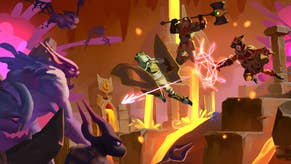Inkbound review - another stand out roguelike by the Monster Train team
The blot thickens.
This time it's Hades that Shiny Shoe's game feels similar to, but with some delicious differences that make this roguelike stand out all on its own.
To understand the allure of Inkbound, you have to understand a bit about the developer making it. Shiny Shoe made a game called Monster Train that came out a few years ago, and it was a roguelike deck-building game influenced by Slay the Spire, but imaginative enough to spin that influence into its own thing - and then good enough to deliver it. That's not an easy genre to stand out in, but it did. Understandably, there was a lot of excitement for what the studio would do next, and Inkbound is it. And whisper it, but I believe Shiny Shoe has done it again.
Slay the Spire isn't the dominant influence this time; Hades is. There's one huge difference in that Inkbound combat plays out in turns, rather than in real-time - and that it's got optional multiplayer co-op for you and three others - but otherwise, so much feels the same. The way you start from scratch and build and modify your character through a run feels the same, as does having a choice of rooms to progress onto after you beat an encounter. The hub you return to where characters wait to speak to you and give you quests also feels the same, as do the dialogue panels that pop up when you talk to them. Heck, the game's whole tone doesn't feel that far removed. So there's a lot of Hades here, and maybe that sounds derivative but it isn't - Shiny Shoe has spun the formula again in a way that's beautifully its own.
Broadly, Inkbound is a roguelike where you get one life (repeatedly) to see how far through the game you can get, and then in between runs, you return to a hub to talk to people and complete quests before trying again. The theme of the game is the written word, hence "Ink" in the title, which lends the game a papery and storybook quality, and you're on a mission to return ink enemies have stolen in order to return stability to the world. Something like that. It's a bit confusing, but it does what it needs to do and provides an imaginative backdrop to the mechanics of what's going on. More importantly, it never gets in the way - it's there to gradually absorb as you loop back around again.
As with Hades, when you begin each run, you start from scratch with only a few abilities to use, known as Bindings here, and the Bindings you start with depend on the classes you choose. There are four unlocked to begin with, and four more to unlock as you play, and they're a varied bunch, changing quite significantly in complexity from easy whacky hammer character to intriguing 'thread enemies together' character. An eclectic bunch.
As you progress, you'll earn rewards that will improve - or "augment" - the Bindings you have, and introduce new ones. These will do various things, from increasing their range and damage, to adding new effects and with them, creating combo possibilities, and so on. Later on, you can transform the entire Binding itself. What you can do also depends on the rarity of what you're offered as a reward. There are a few tiers, and the rarer ones are reserved for tougher battles. With this in mind, the game will offer you harder encounters alongside standard ones, to tempt you. I always go for them - it not only makes for better rewards but makes the game more challenging, and therefore interesting, as a result. The same rarity risk-reward is true for items you can collect - Vestiges - that offer you passive benefits, and if you're smart, combine with the abilities you're using to devastating effect.


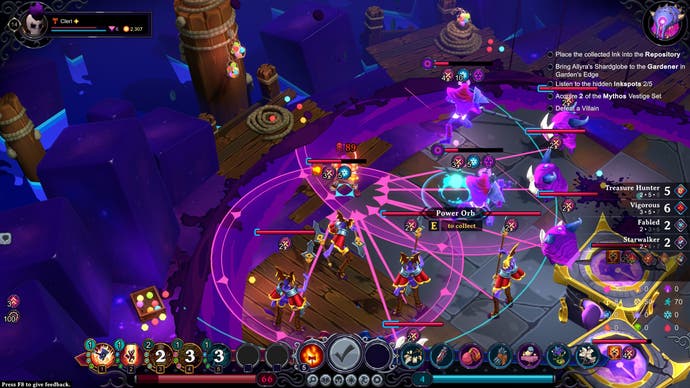
So far, so Hades - the big difference revolves around combat. As I said, it's turn-based, and it takes place in small circular arenas that gradually get more unsafe as mini-battle royale storms close in on them. At the top of the round, enemies appear and showcase their intentions for what they're going to do at the end of the turn. They might be about to attack in a particular circular area, they might be about to charge in a corridor-shaped path, or they might be about to attack you directly, or something else. Whatever it is, you need to look at it all and figure out what to do. Or, more to the point, where to move to in order to get safe.
Positioning is vital in this puzzle but you only have so much resource movement to use, and when you start encountering enemies whose attack directions change when hit, you can find yourself inadvertently trapped in shifting attack zones and facing a bucketload of damage. Complicating the movement puzzle this further are Will pick-ups - Will being the resource you use to power abilities - which often lie just out of reach, or in the middle of danger, and tempt you into taking risks. The skill of combat, then, is in doing damage but also avoiding it. It's in starting the round with an overwhelming barrage of damage poised to be unloaded on you, then skillfully weaving your way out of it with a mix of avoidance, killing, and damage negation.
The magic of Inkbound is in how this all comes together. The game is so well tuned. Within a few minutes, you're in a run and battling - there's never any hanging around. Nor is there ever any padding, really. The gradual ramp-up of challenge you have in a game like Slay the Spire and even Hades, where you face a few trash battles, is negated here by the option of hard battles every time. This supercharges your growth and provides you with challenging battles each time. In general, there are fewer fights too, making what's there feel more meaningful and the rewards for them more plentiful. Inkbound is generous. Shiny Shoe clearly understands that the allure of these games is building characters that break the mould in wonderfully satisfying ways, and it feels like it's doing all it can to enable that, if, of course, you put it together right. I've managed it a few times and it feels deliriously fun, not least because when things don't come together, the battles are genuinely tough - Inkbound shows you both sides.
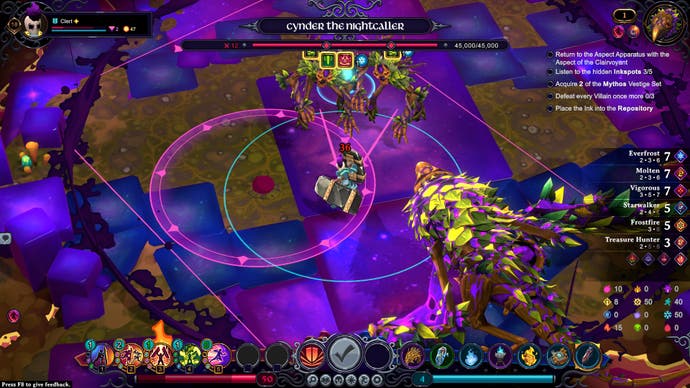
There's always a sense of momentum in the game too - everything feels like it's pushing forward. When I played it in Early Access a year ago, the core already sparkled, but now around it, there's more of everything. More depth, more character, more finesse. There's more to do each time you loop back around - more characters to talk to, more quests to take on that you probably won't think much about, but you'll enjoy the little firework pops of progress they are responsible for, igniting across your brain. As you go, you'll level up, unlocking more Vestiges for your item pool, and more cosmetics, and there's always a sense that there's something more to do - even a dozen hours in and a few successful runs later. There are more character classes to get your head around and unlock; there are more bosses and ultimate bosses to find your way to - or back to, as the case may be; and there are more systems to really figure out.
One system I'm currently obsessing over is Sets, which is an additional layer of character power that comes from, of all things, sacrificing the items you collect. You might love them, and they might combine with your Binding abilities really well, but if you sacrifice them, you'll get significant progress on a Set scale, which offers powerful passive abilities too. What do you do? I've never faced that kind of choice before, and it's in little things like this I really appreciate what Shiny Shoe does. It's always looking for a new way to spin something, to add a mechanic, to tinker.
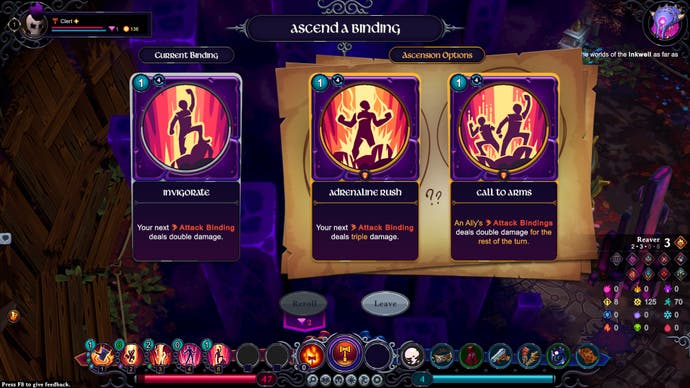
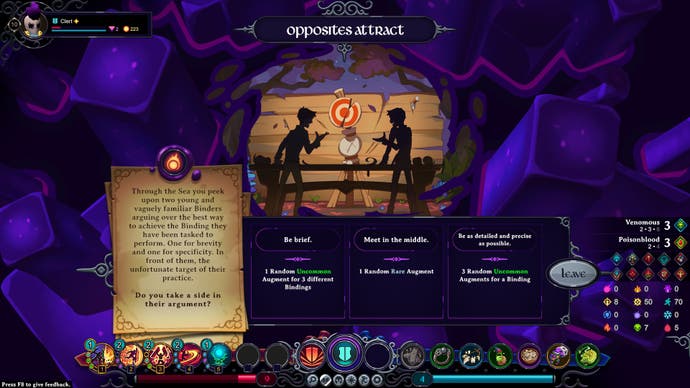
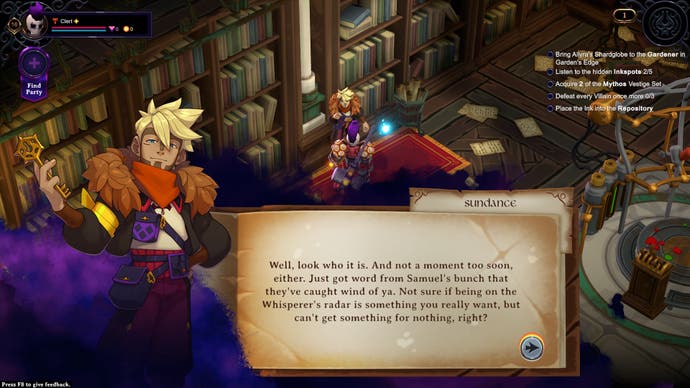
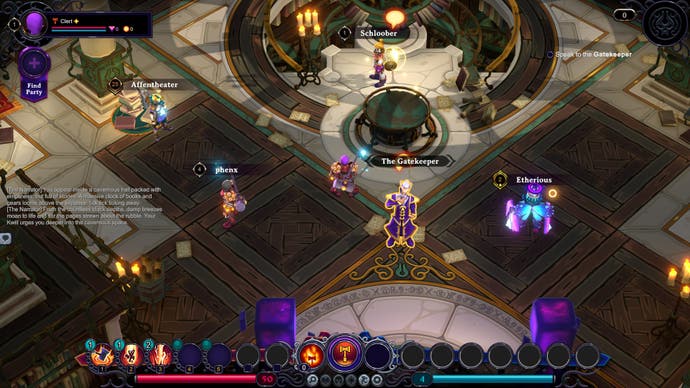
I do have some gripes: I've never particularly enjoyed the art style of Inkbound. It's bright and colourful, I'll give it that, and it probably runs on any machine, which I expect is a significant reason for it, but the player characters in particular look clunky and dated. It's a long way from the delicate charms of something like Hades. I've also had some awkward moments with controls in combat where I can't see all of the battlefield, and when I pan around holding Shift, I sometimes trigger an ability I didn't mean to and it lands me in trouble. On a related note, I don't think you can pan around at all using a controller, and I can't check it because there are no visible settings for controllers that I can see in the menus, which seems an odd omission.
Multiplayer is a new area to me, too. The build I was playing before release didn't have anyone around to group with, but on the live servers, there are many. They all populate the hub area you explore, slowing it down somewhat as the server processes what you're doing, which is frustrating. Partnered for a mission, the experience is different too. The game seems to scale the challenge and provides multiple Will pick-ups depending on the size of your party. Coordination and communication are key, here, because other players might move enemies in ways you do not want, or collect Will pick-ups you were counting on. You don't have the total control you will be used to from the single-player experience, and I'm not sure I like that. But I do like how some Binding upgrades are tailor made for party play; that's a nice touch because it introduces group dynamics. Also, it might just be teething problems, but I encountered noticeable lag while playing with other people. However, you can set yourself to offline and ignore multiplayer completely if you want to.
But these are footnotes for what is otherwise a showcase of joyous expertise on the part of Shiny Shoe. Few games are as immediately engrossing as Inkbound, even taking into account the slightly unusual combat, and few games are then as consistently entertaining. Don't be put off by how it looks - Inkbound, like Monster Train before it, is another stand-out in the roguelike genre.
A copy of Inkbound was provided for review by Shiny Shoe.



